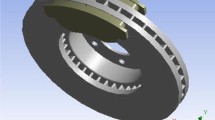Abstract
The primary purpose of this basic research is to investigate the structural and mechanical behavior of a three-dimensional disc-pad model during the braking process under dry contacts slipping conditions. A predictive analysis is performed in order to determine the global deformations, Von Mises stress on the disc, and contact pressures on the inner and outer pad at different time of simulation. We first proceed to view the meshed models and predicting variations of tensile or compressive stress normal to the plane and shear stress in rotating disc and ring bodies. In addition, we discussed the sensitivity of some parameters involved in the results of mechanical calculation, such as rotation of the disc, the smoothness of the mesh, the material of the brake pads and the friction coefficient that enters the disc and the pads, the number of revolutions and the material of the disc, and the pad groove.
Similar content being viewed by others
References
Tajan N, Mac-Lan T (2002) Modélisation thermomécanique des disques de frein par une approche eulérienne. Thèse de doctorat de l’école polytechnique-spécialité mécanique des solides
Reibenschuh M, Oder G, Cuš F, Potrč I (2009) Modelling and analysis of thermal and stress loads in train disc brakes. Stro J Vestn-J Mech E 55(7–8):494–502
Subramanian PM, Oza D (2015) Strength analysis of a ventilated brake disc-hub assembly for a multi-utility vehicle. Int Res J Eng Technol 2(2):726–730
Shinde NB, Borkar BR (2015) C.A.D. & F.E.M. analysis of disc brake system. Int J Eng Comput Sci 4(3):10697–10706
Jungwirth F, Dornheim A, Friedrich C (2014) Coupled thermo-mechanical computation method for a virtual design processes of brake discs. Proc. 11th World Congress on Computational Mechanics (WCCM XI), pp. 1–10
Söderberg A, Andersson S (2009) Simulation of wear and contact pressure distribution at the pad-to-rotor interface, in the disc brake using general purpose finite element analysis software. Wear 267,12(1):2243–2251
Abdullah OI, Schlattmann J, Al-Shabibi AM (2013) Stresses and deformations analysis of a dry friction clutch system. Proc. 13th International Conference on Tribology, Serbiatrib’13Kragujevac, Serbia, pp. 210–216, 15–17
Dhiyaneswaran S, Amirthagadeswaran KS (2014) Comparative study of disc brake materials through computer aided engineering. Int J Mod Eng Res:173–179
Sharath Kumar T, Vinodh S (2012) Novel design and analysis of a brake rotor. World Acad Sci Eng Technol 6(1):523–525
Belhocine A, Bouchetara M (2012) Thermomechanical modeling of dry contact in automotive disc brake. Int J Therm Sci 60:161–170
Belhocine A, Ghazali NM, Abdullah OI (2014) Structural and contact analysis of a 3-dimensional Disc-Pad model with and without thermal effects. Tribol Ind 36(4):406–418
Belhocine A, Abu Bakar AR, Abdullah OI (2015) Structural and contact analysis of disc brake assembly during single stop braking event. Trans Ind Inst Met 68(3):403–410
Yildiz Y, Duzgun M (2010) Stress analysis of ventilated brake discs using the finite element method. Int J Auto Technol 11(1):133–138
Magnain B (2006) Développement d’algorithmes et d’un code de calcul pour l’étude des problèmes de l’impact et du choc. Thèses de doctorat de l’université d’évry –val d’essonne
Coudeyar N (2009) Analyse non-linéaire des instabilités multiples aux interfaces frottantes: application au crissement de frein. Thèse de doctorat de l’école centrale de Lyon-spécialité: mécanique
Abu Bakar AR, Ouyang H, Cao Q (2003) Interface pressure distributions through structural modifications. SAE Technical Paper 2003-01-3332
Cueva G, Sinatora A, Guesser WL, Tschiptschin AP (2003) Wear resistance of cast irons used in brake disc rotors. Wear 255:1256–1260
Author information
Authors and Affiliations
Corresponding author
Rights and permissions
About this article
Cite this article
Belhocine, A., Omar, W.Z.W. Three-dimensional finite element modeling and analysis of the mechanical behavior of dry contact slipping between the disc and the brake pads. Int J Adv Manuf Technol 88, 1035–1051 (2017). https://doi.org/10.1007/s00170-016-8822-y
Received:
Accepted:
Published:
Issue Date:
DOI: https://doi.org/10.1007/s00170-016-8822-y




